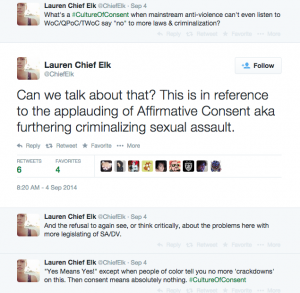On Sunday, Governor Jerry Brown of California signed into law a hotly-discussed bill that introduces a new definition of consensual sex for all colleges and universities to use when investigating claims of sexual assault. These institutions will now be required to evaluate sexual assault cases under a new “affirmative consent” standard, known colloquially as “Yes means yes,” in order to receive state funds. The change marks a paradigm shift away from the traditional conceptualization of sexual assault, which has often invoked the phrase “No means no” to emphasize that consent ends when one person denies the sexual advances of another, toward an attitude that emphasizes the proactive, enthusiastic giving of consent.
Activists who have rallied for the shift to “Yes means yes” have argued that the change will correct the long-standing idea that it is essentially up to the victim to resist an attacker’s advances in order for the act to be considered – and punished as – sexual assault. Instead, as the law states, “it is the responsibility of each person involved in the sexual activity to ensure that he or she has the affirmative consent of the other or others to engage in the sexual activity.” The law defines affirmative consent as “affirmative, conscious, and voluntary agreement to engage in sexual activity” and clarifies that “lack of protest or resistance does not mean consent, nor does silence mean consent.” [emphasis mine]
Feminists have hailed this as a victory for multiple reasons: (1) The United States has an alarmingly high nationwide campus sexual assault rate (One in five college women has reportedly been sexually assaulted); (2) there is a concerning tendency for colleges and universities to sweep allegations of sexual assault under the rug in the name of protecting their reputations; and (3) we live in a culture in which women’s bodies are often seen as constantly available for male sexual consumption – in other words, feminist activists have traditionally had to rely on the language of “no means no” because it is almost assumed that, without that explicit explanation, women are seen as ready for the taking. As Denice Labertew of the California Coalition Against Sexual Assault (CALCASA) explains in a great piece by Callie Beusman over at Jezebel:
“[Affirmative consent] requires us as a society to acknowledge that victims’ bodies, particularly women’s bodies, are not just available until they say they’re not available…This idea that women should have to say no or indicate that they don’t want to have sex assumes that their bodies are just automatically available.”
Critics of the bill, however, have hopped on what they see as a slippery slope created by a vague new definition of consent that leaves itself open to wide interpretation and, they say, is not in keeping with the nature of human sexual interaction. They raise concerns that it is unrealistic to expect partners to continuously, explicitly check-in with each other throughout the course of a hook-up and that the new “yes means yes” standard will open the door to false accusations of rape. They say that the new attitude propagated by advocates of the law will cause young women to over-analyze and reinterpret consensual sexual encounters after they happen, concluding that they were raped because they never gave explicit, vocalized affirmation. And they say that the new standard to be used in college disciplinary boards amounts to a presumption of guilt of the accused, directly in opposition to the golden standard of innocent-until-proven-guilty.
What these critics miss, however, is the real-world situation to which this law is a reaction. In the case of any law, a critic can concoct a theoretical situation in which some wayward person might try to exploit the law and falsely accuse another person. (And of course, even without a “yes means yes” legal standard, someone can still theoretically falsely accuse someone of rape.) In the real world, however, we have a situation in which false rape accusations are incredibly rare, and those who do come forward with allegations at colleges and universities are regularly given the run-around by basically every entity on campus until they generally give up, exhausted and emotionally/mentally scarred. Colleges and universities have shown time and again that they prefer to protect their reputations rather than take action in the case of sexual assault, meaning the victim is forced to stay in close proximity to their rapist for the duration of their time at school. Sadly, the story that plays out in too many cases involves the victim struggling against an unresponsive administration, slipping further into mental health problems, watching their grades slip, and sometimes dropping out entirely – all while their attacker continues his normal life at school as if nothing happened. It is this reality that has prompted the U.S. Department of Education’s Office of Civil Rights to open investigations into how charges of sexual assault are handled at 79 schools across the nation [the number of schools has gone up since the linked article was published].
In the light of such things, the biggest concern from a standpoint of justice is not whether someone could theoretically hyper-analyze a past sexual encounter in an inaccurate light and then somehow convince the college advisory board to wrongfully throw a young man off campus, but rather the fact that sexual assault survivors very rarely obtain justice from their school administrations. In other words, we already have a status quo in which justice is not being served – those who worry about a scary new world in which people will be falsely accused en masse seem to be ignoring this basic fact. The standard of affirmative consent basically enables a victim to obtain justice even if she/he didn’t “resist enough” during a rape – a real possibility, given the effect that fear, alcohol and/or drugs could have on a person’s ability to clearly and firmly say “no.” A particularly vivid example of one such instance in which justice was not served – but might have been under an affirmative consent standard (in addition to a much more responsive school administration) – comes from this op-ed from a former Harvard student that went viral this spring.
There is one critique of the new law that takes a slightly different approach – the charge that while it is a laudable goal to try and shift our culture away from a view of women as constantly sexually available, it is wrong-sighted to try and accomplish such social change via the law. Cathy Young argued this point in her oft-cited article in Time: How appropriate is it to use the strong arm of the law to try and initiate a cultural shift in our bedrooms? This question has electrified feminist circles for decades and could seem apt right now – except that we are discussing a matter of sexual violence, not sexual politics. And while the question about the government’s place to act would be worth debating if it were simply a matter of initiating a national cultural dialogue, in this case the matter at hand is far more concrete. Indeed, the national conversation has started and feminists are wise to use this moment to try and get people talking about equality in sexual relations – but this whole question of affirmative consent did not begin as a political discussion. It started as a response to the real pain felt by real victims who were not being served by their school administrations. It is only because of these shortcomings in the system that any of us are having this conversation in the first place. The heart of the new law in California is meant to bring about concrete changes, not theoretical ones.
Related to this question of methodology, there have been feminist critics who are concerned about the approach enshrined in the law, which they call “corporal feminism.” They say that relying on tougher legalistic frameworks and increased policing to solve gender-based problems doesn’t work in a system that is historically and routinely dismissive of victims of interpersonal violence [note on language: “SA” = “sexual assault”; “DV”= “domestic violence”; “WoC/QPoC/TWoC”= “Women of Color/Queer People of Color/Trans Women of Color” ]:
These critics also point to the problem of using a legalistic approach, given the history of racism within the United States judicial system (and parallel blind spots among mainstream white activist groups to recognize this issue):
While the new law in California is focused solely on college campuses and applies only to school disciplinary boards charged with determining who will remain a part of their respective school communities (rather than law enforcement, which is obviously charged with legal punishment), I think the spirit of these critiques is important. Such critics go beyond Young’s argument about the problem of using the law to create cultural shifts, and point to the potential for the new law to either fail the very victims of violence it purports to help, or to further exasperate racial injustice. Both concerns are based on real knowledge of the justice system’s track record with regards to sexual assault survivors and communities of color, making the critique much different from hyperbolic fears of false rape accusations and retroactively reinterpreted sexual encounters blossoming left and right. I do think it’s important to examine these concerns moving forward – doing so may very well reveal some changes to the “yes means yes” approach that are needed as we move forward. But such attempts should not be misconstrued as some sort of admission that claims of sexual assault are overblown or that we are somehow doing too much to help victims of sexual assault.






